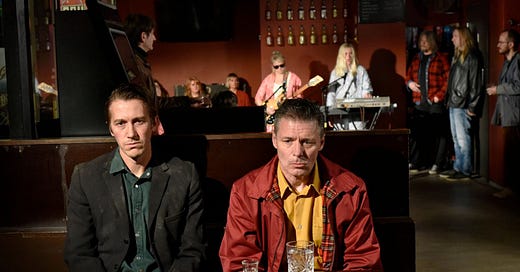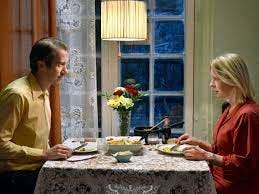Fallen Leaves is the 20th film by Finnish director Aki Kaurismaki. The story charts the peaks and troughs of a romantic courtship between two desperately lonely people: Ansa and Holappa. Aside from the presence of radio reports of the Ukrainian and Russian conflict and mobile phones, the visual aesthetic could just as easily have existed in the world of 1970’s Communist Russia. Both characters work uninspiring jobs where any sense of security or upward mobility is non-existent. Holappa uses alcohol to anaesthetise himself against the mundanity of his daily existence, working as sandblaster and living onsite in squalid conditions. Ansa surreptitiously takes food products home from the supermarket she works in to stave off imminent hunger. Two souls unaware that the remedy for their isolation is in each other’s arms.
Kaurismaki and cinematographer have fashioned a world similar in tone and atmosphere to that of Swedish director Roy Anderson, noted for his often surreal and absurdist approach to visual storytelling. It is a world hermetically sealed off from any reality we know but also contains enough familiar visual cues to ground us in a world which is recognisable. It is however the very human yearning for love, companionship and affection present in the film which invites the viewer in. In our postmodern, post-industrial and post-truth world, the fundamental truth of love pierces through it all. It is why we are here. It is why Holappa and Ansa are here.
The film is also very cine-literate with several references to other movies and a cameo by fellow Finnish director Juho Kuosmanen. The two protagonists go to the cinema together and watch The Dead Don’t Die, a Jim Jarmusch film which featured in Cannes in 2019. Incidentally, Jarmusch and Kaurismaki are long time friends and possess a very unique visual style, unique to themselves. In some ways, the tenderness of the love story in Fallen Leaves is reminiscent of Jarmusch’s gem of a movie Paterson, previously reviewed here - https://neilgarvey.substack.com/p/paterson-2016. Their films are unmistakably theirs but also full of heart.
Salvation in friendship is also depicted in Fallen Leaves in the characters Huotari and Liisa, friends of the two protagonists. In fact, they are the bridge that brings the two together sparking up a conversation in a dingy karaoke bar and in turn bringing Haloppa and Ansa into each other’s radar. In a beautifully comical yet heartwarming scene, Huotari announces that he is about to take the stage and sing in the karaoke bar, much to the surprise of Haloppa. We watch, as the audience is entranced by his performance which is in equal parts a shambles and a success.
The soundtrack introduces the viewer to several Finnish love songs which punctuate and comment on the proceedings through Ansa’s radio in her apartment. The songs seem familiar yet so alien at the same time, the same feeling one gets when visiting a foreign country realising there exists a musical heritage you have no knowledge of, but you can still recognise the same themes and leit motifs from your own musical heritage. The film operates on a similar level to this - a mixture of otherness and familiarity.
In our disconnected and atomised world, a film like Fallen Leaves seems to have resonated with audiences and critics alike. It manages to straddle that problematic line between style and story-telling pretty well. However there were moments where the film was teetering on the edge of the stylistic abyss but thankfully Kaurismaki reined it in and refocused on the beating heart of the film - the embryonic love between Ansa and Holappa.





